The hidden highlights of England’s new answer to Route 66
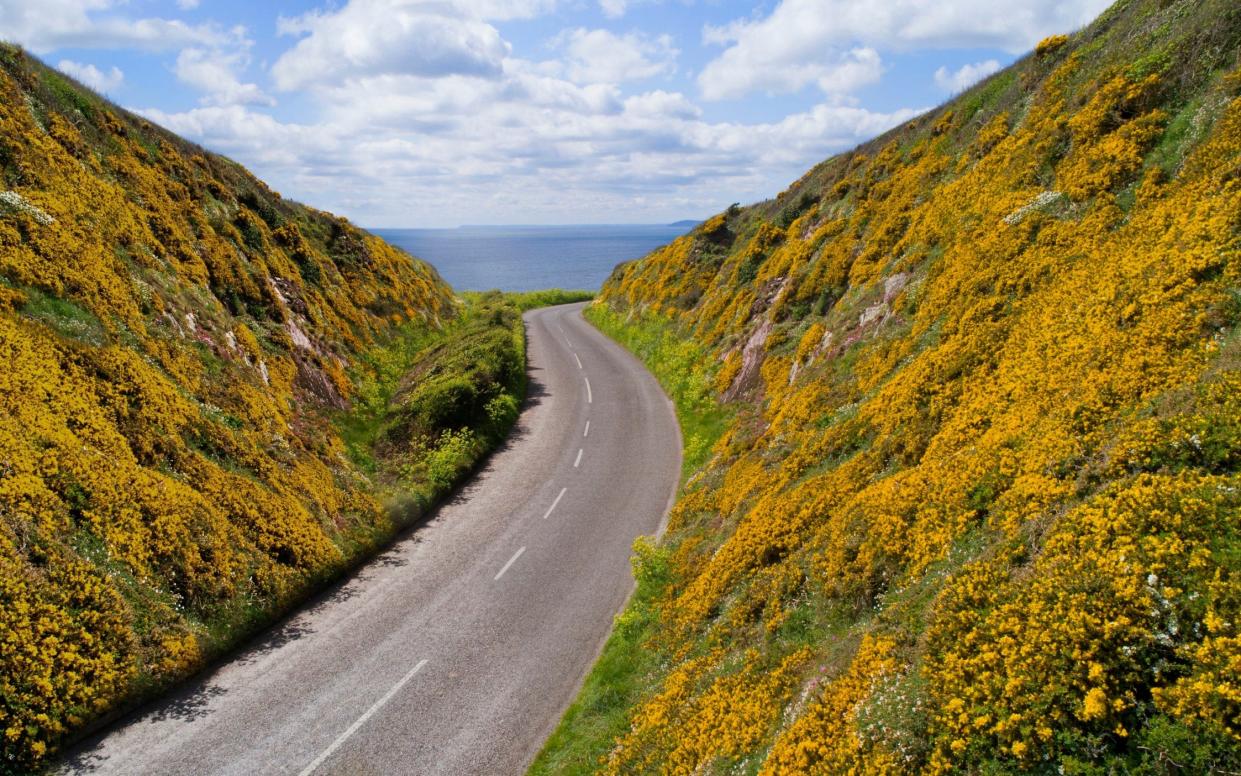
Coast roads can be deceptive. I’ve set off on many only to find they veer inland, miss the best beaches, affording views not of sweeping sand but of gridlocked villages and farmers’ fields.
The launch of SouthWest660, a 660-mile route along the littoral from Poole to Watchet, via Land’s End, sounds like a great idea. The cliffs and coves, strands and surf spots of Dorset, Devon, Cornwall and West Somerset are rightly famous – a magnet not only for inlanders but for northerners and Scots who willingly do the long drive down, opting for Bude and Newquay, Minehead and Paignton over nearer seaside towns.
The South West Coast Path already offers walkers a wonderful experience of the wild edges of the region. We’re always being told we need to do exercise, so isn’t a 660-mile car trip a bit excessive, a significant carbon dump as well a potential traffic problem for the destination?
But South West 660, a commercial venture set up by three locals, aims to be a guide rather than a challenge. Its website contains a map and local information, and members can get more detailed notes, downloadable GPX files and discounted meals for the princely sum of £15 for 2 months. As co-founder Mark Godfrey notes: “Each of the 12 sections is around 50 miles long, allowing visitors to take their time and experience the diversity and splendour of our beautiful corner of the UK.”
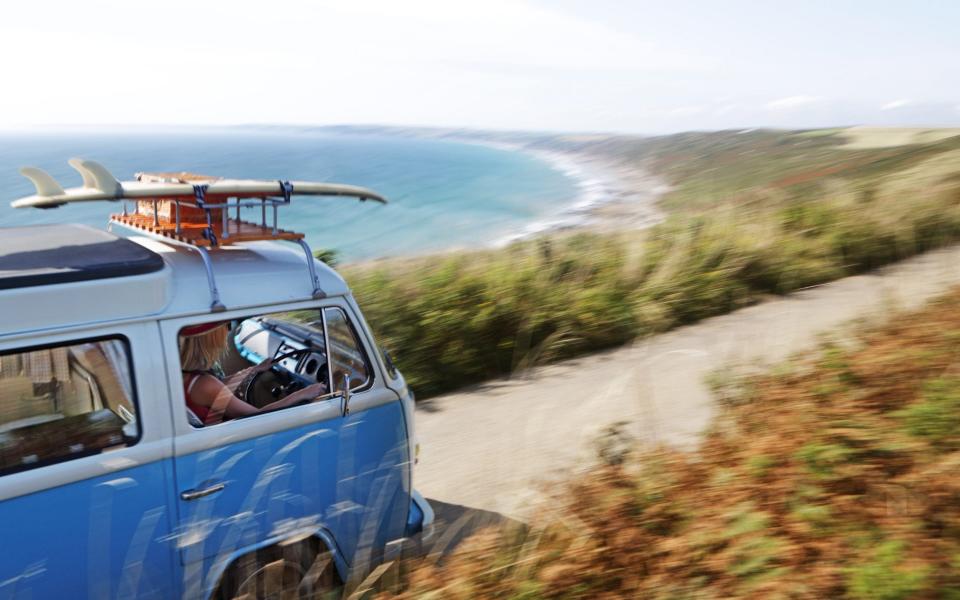
I suppose the founders were inspired by Ireland’s hugely successful Wild Atlantic Way, launched in 2014, and the wall-to-wall coverage generated by Scotland’s North Coast 500, which opened in 2015. But the former is a whopping 1,553 miles long and many areas of Ireland’s west are not heavily congested; it also received millions of euros from the Irish government to pay for signage, new walking and cycling trails, and visitor centres. The latter has brought boy-racers to once-idyllic roads and led to an increase in accidents.
I have driven sections of the Irish coast route and was very impressed with the concept. I have taken the road to Cornwall many times, admittedly using the throbbing A30 and A39 trunks, and I have to admit not always enjoying Devon’s hemmed-in lanes. The South West 660 is already generating warm online chitchat, including by motorhome owners – which makes me shudder.
But there’s no reason why this road trip can’t be a boost for parts of the South West that don’t already get hordes of tourists. Drivers need information about parking and live feeds of accidents. E-car drivers need plugging-in sites. The website team should dispense tips on “what to avoid” and hire some historians, culture-vultures and archaeology buffs to provide really original local insights.
A strictly coastal drive means shunning Totnes, Dartmoor, Bodmin Moor and other inland delights. Personally I’d drop Salcombe and Padstow and make a few inroads if you’ve not driven down here before. But driving holidays can be delightful, especially when taken slowly, with lots of stopping and consideration for other road users and walkers.
My 10 unmissable highlights on the route
Higher Bockhampton – Hardy Country
Great books have been conceived and written all over the West Country, from Daphne du Maurier’s Jamaica Inn to Winston Graham’s Poldark series. But no author speaks to their landscape like Thomas Hardy, who found in the rolling hills, market towns and ancient byways of Dorset a universe as complete as anything Tolkien could dream up. A pint in the King’s Arms in Dorchester is a must, and then you should drive up to Higher Bockhampton, to see his birthplace, and do a short walk through “Hardy Country” to Max Gate, his home from 1885-1928 – now a National Trust property. And yes, I know I’m not strictly on the coast as we set off, but Weymouth is only 20 minutes away.
West Bay – Jurassic lark
Ammonites, with salt and vinegar, please. To be honest, anywhere on the Jurassic Coast is worth a stop. The looming gold-tinted cliffs, the long sweep of the beach and the raw fame of the place make it feel special. Lyme Regis has a literary loveliness, Seaton is a proper seaside town, Sidmouth has its Regency airs and graces. I like West Bay because one minute you’re wandering around dozens of small chippies – fish and chip kiosks that offer such similar fare they could be nationalised and you wouldn’t notice – and the next you’re out there on the remarkable strand, at the far end of Chesil Beach, beneath crumbling walls of sand. Everyone is laughing and wiping chip grease and ice-cream slops on to their swimming cozzies, watched over by cliffs full of prehistoric secrets.
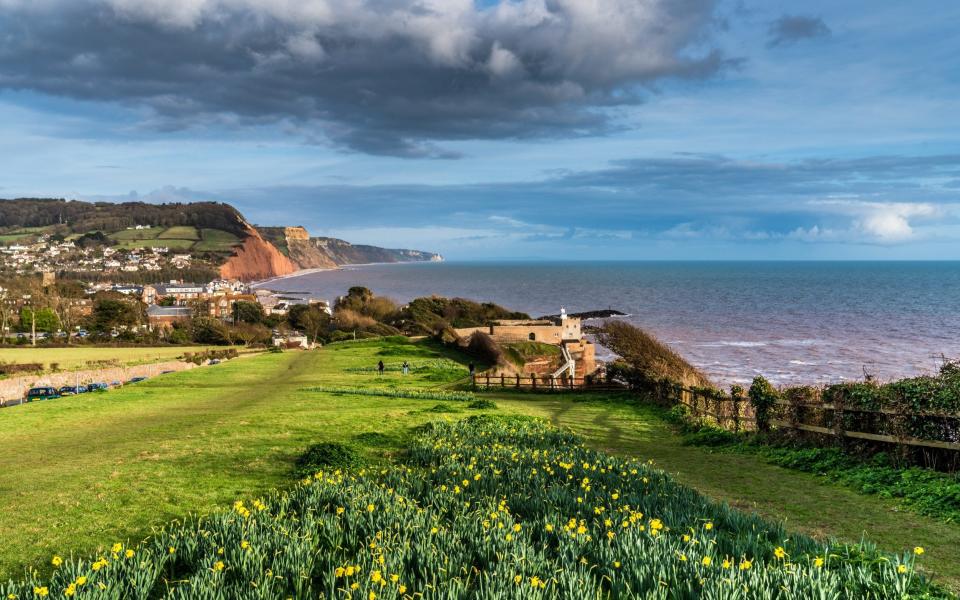
Ayrmer Cove – Serene swims
South Devon is awash with bathing options. From Torbay to Plymouth Sound are long and short stretches of sand and shingle. But most come at a price. Slapton’s pebbles and exposure to the elements impose limitations. Busy Bantham is reached by a narrow lane, involving tedious pulling over and reversing. Ayrmer Cove is found by diverging off the main road to Bigbury-on-Sea, with a National Trust car park at the end, with an honesty box. It’s then a half-mile walk down a track to the beach, where there’s comfortably room for 30-40 groups or families. The sea is calm and shallow, and warms up a bit on hot days. At low tide, you can see an island; at high tide, you can swim out to it. Natural, simple, framed by cliffs, it’s a great spot. It has a price, too. No caffs or services and no loos, but the Journey’s End is a good pub just a short way up from the car park track.
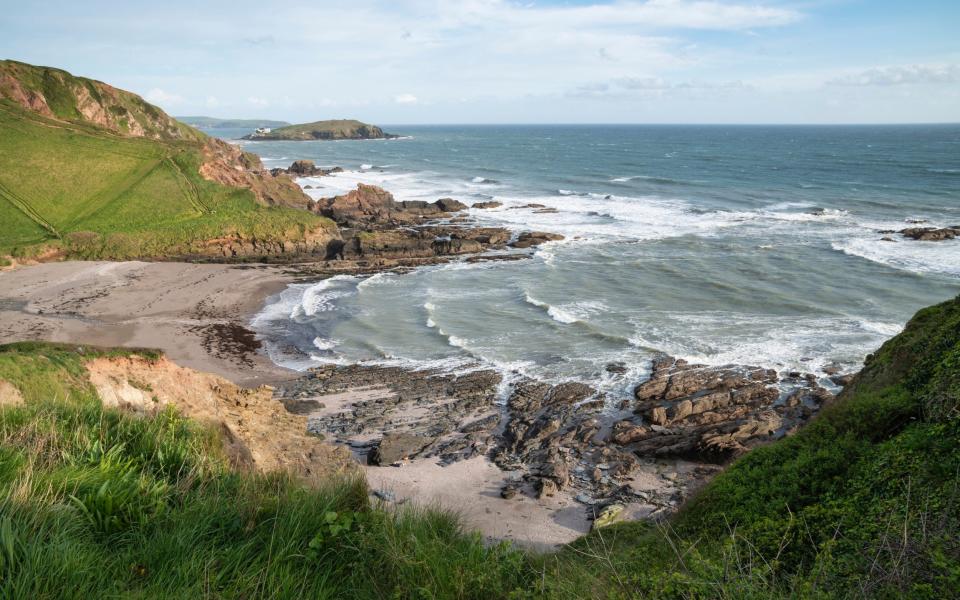
Plymouth – The Hoe
The most underrated city in England? Maybe. The city itself is interesting, as all British cities are, for its eclectic architecture: the post-war concrete of Armada Way, pretty Victorian Workmen’s dwellings on Looe Street, the cobbled medieval mish-mash of the Barbican. But Plymouth is even more impressive when you turn your back on it at the Hoe, swapping the Georgian Terraces for one of the most attractive bays in Europe – Plymouth Sound, which lies between the verdant headlands of Penlee Point in Cornwall and Wembury Point in Devon. Smeaton’s Tower looms over statues of Drake and Nancy Astor; below is the art deco Tinside Lido and a great terrace bar-café. There’s good food and proper old pubs down around the Barbican.
Fowey and Golant – Oo-aar Cornwall
All the towns and large fishing villages of the Cornish coast have appealing qualities, and throngs of visitors. Fowey is not as quaint as Polperro, but it affords some breathing space and the estuarial location is lovely. The church, harbour and centre are worth an hour and you’ll find plenty of cafés and pasties (Kittows is good) to fuel up. An easy half-mile walk is along the Esplanade to the beach at Readymoney Cove. If you’re up for something a bit more energetic, there’s a well-marked 4-mile section of the Saints’ Way (the probable route of Christian pilgrims) along the River Fowey, through woods and sheep-fields, to Golant. The latter is a gorgeous little village that changes its mood with the weather and tides. The Fishermans Arms is a popular pub with and old-school lounge and outdoor benches; incomers or emmets are buying up the flash places but you’ll still here proper accents and might even catch a Morris session here.

Falmouth – Maritime grandeur
When Britannia ruled the waves, her seaports were as important as her mercantile cities. Falmouth is pretty much the last significant stop before the Channel opens out in to the Atlantic Ocean. The old quay here evokes memories of cutters and clippers, but this is a working harbour and there’s always a chance of seeing a serious naval vessel or two. By the docks is the outstanding National Maritime Museum, with twelve galleries set over three floors with full-size and model boats, plus displays on weather, wildlife and maritime history. It’s all interactive and child-friendly. This summer there are special shows about ‘Monsters of the Deep’ and tattoos. Falmouth Art Gallery has a strong collection of local works. But it’s a lovely town just to walk around, taking in the lush gardens and grand terraces.
Penzance – pirates and pints
Another cracking town, with that edgy energy you get where a diverse bunch of locals and outsiders wash up. But Penzance is no Stroud or Hebden Bridge. It’s a last fling at urbanisation before Land’s End and has chain shops and traffic and supermarkets, but also lively local pubs with salty names – Dolphin Tavern, Navy inn, Turks Head, Admiral Benbow – and good company, as well as a decent splash of places to eat. Chapel Street has fine architecture and antique stores, and Tremenheere Sculpture Garden and Tanglewood Wild Garden are an enticing yin and yang of green spaces. Penzance is a perfect base for tripping out to see Mousehole, and Newlyn, for its art gallery, and Porthcurno Beach.
Stepper Point: wild walks and sea breezes
I was torn between recommending this and Start Point, South Devon’s lovely lighthouse and headland. But I did the seven-mile walk from Harlyn Bay to Padstow via Stepper Point in 2020, in a bid to get away from the masses of families cluttering the Harlyn Bay and Trevone Bay beaches. The numbers were inflated because of the pandemic, but I expect they’re always busy when the sun’s out. Still, once you leave Trevone Beach behind, things really improve, with a stunning cliff-top walk at eye-level with fulmars and kittiwakes. Padstow is always heaving, but you can get a good bag of fish and chips from Chip Ahoy and hide from the crowds in the bosky park at the top of Mill Road or on the benches north of town, overlooking the River Camel. If you want something special, Michelin-starred Paul Ainsworth at No 6 is in Padstow, and a certain Mr Stein has three venues and a chippy.

Croyde – world-class rollers
In early April, North Devon became only the 12th World Surfing Reserve in the world, placing Croyde, Saunton Sands and Woolacombe alongside the likes of Santa Cruz, California, and Australia’s Gold Coast. The Save the Waves coalition chose the region because of the “high quality and diversity of surf breaks“ and because it represents the “quintessential UK surf ecosystem” – which, translated into landlubber means, mirror sunglasses, bleached hair, ripped bodies and dirty suntans. But it really is quite a thing to park up here and watch the rollers. Beach walks, the hike up to Baggy Point via Bloodhills Cliff, and nature trails into the North Devon AONB mean it’s not all about the waves.

Minehead – The ultimate nuclear family holiday
For the last stop I was torn between Lynton and Minehead, but since you’re driving 600 miles you’ll see the former anyway – and it’s not always easy finding parking there. Minehead still has the Butlin’s holiday camp that opened in 1962, and the resort exudes a fun, unpretentious spirit – and plenty of parking. It has a broad beach that shimmers under the sun, and Exmoor rises up behind the town. A train ride on the West Somerset Heritage Railway to Watchet takes you to the end of the official SW660 map – and there is no finer way to conclude an epic journey – but I can also recommend the walk from there to Hinkley Point.
Five places to stay
Gara Rock, near Salcombe
One of Devon’s coolest hotels, perched on a bluff with striking views and tumbling gardens. Rooms are rustic-chic and there’s a great glass-walled restaurant and a bar stocked with West country gins and ciders. B&B from £140. gararock.com
Chain Locker, Falmouth
Lovely 17th-century sailors’ boozer reimagined as a boutique hotel. Refurbished by owners brewery St Austell, it’s not been overly dolled-up; the pub-part still has its flagstone floors, dark wooden beams, nooks and crannies. The six rooms are a smart mix of grey palettes, vintage furniture and retro photographs. B&B from £90. chainlockerfalmouth.co.uk
Chapel House, Penzance
A handsome brick-and-granite Georgian townhouse, once the home of an admiral, and now boasting six large double rooms that blend period and contemporary décor. A communal ‘supper club’ dishes up wild food and specialises in local produce. B&B from £160. chapelhousepz.co.uk
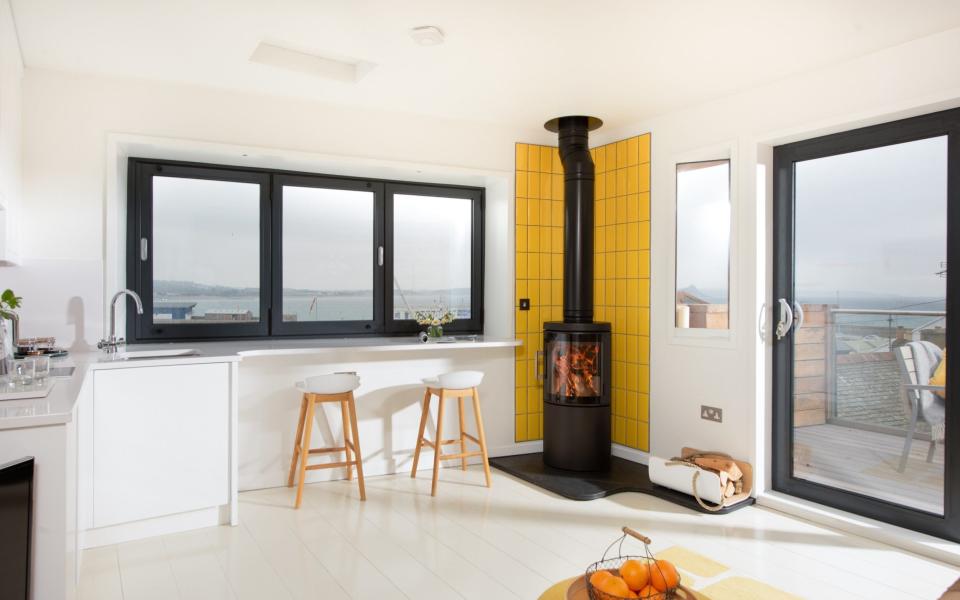
The Pig at Harlyn Bay
Poldarkian and atmospheric, this Cornish outpost of the Pig chain is a grey-stone Georgian house with low ceilings, wonky stone floors, extensive gardens and sunny terraces. Rooms are effortlessly chic and there are four “garden wagons” for those after more privacy. Food is sourced within a 25-mile radius and is top-notch and there’s a great bar. thepighotel.com/at-harlyn-bay/
Longlands, nr Ilfracombe
Take a break from the road in one of five fully-equipped luxurious safari lodges (sleeps six) while soaking up the calm of a secluded valley with its own private lake. A well-kitted kitchen with a woodburner is set up for self-caterers. Dogs welcome. Three nights from £645. longlandsdevon.co.uk
For more places to stay, read our guide to the best hotels in Devon or the best hotels in Cornwall.


